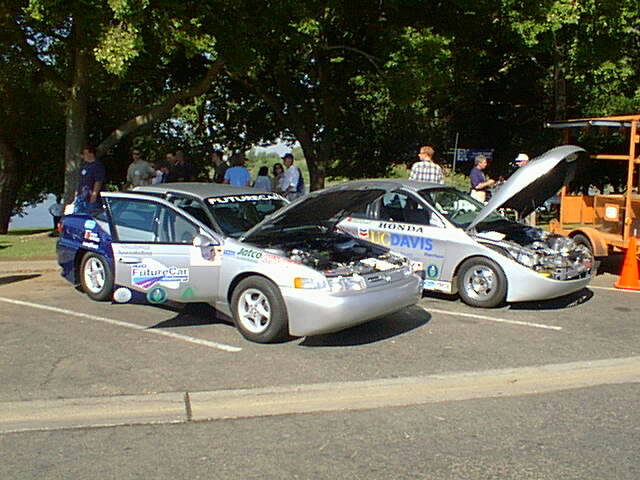
Home - AFV Events - Other AFV Events - ZEVent
In 1990 the California Air Resources Board (CARB), the agency responsible for improving California's air quality to meet Federal standards, created a set of low-emission-vehicle rules that required vehicles offered for sale in the state to include ever-larger fractions of ever-cleaner vehicles, phasing in from the 1993 to 2003 model-years. My 1993 natural-gas-powered van was the first vehicle certified as an LEV, or Low-Emissions Vehicle, several years before they were required to be introduced into the automakers' fleets; today, after years of development, there are gasoline-powered vehicles that meet the even more stringent ULEV (Ultra-Low Emissions Vehicle) and SULEV (Super Ultra-Low Emissions Vehicle) standards. And, of course, this year's natural-gas-powered Honda Civic GX is cleaner than any of these gasoline vehicles!
However, the most controversial element of the rules was that a small but increasing fraction of vehicles offered for sale by the largest automakers would have to be ZEVs, or Zero-Emission Vehicles; until fuel cells become commercially viable for the automotive market, this means battery-electric vehicles (EVs). Originally the rule called for the phase-in to begin with 2% of the automakers' fleets in 1998, increasing to 10% in 2003; however, recognizing the technical challenge inherent in this rule, CARB set a biennial schedule of reviews, and in response to automakers' concerns over meeting these challenges they have softened but not eliminated the rule. At this writing, the phase-in period of reduced requirements before the 2003 model year has been deleted; in its place are a series of Memoranda of Agreement between the state and the automakers, specifying numbers of ZEVs to be placed in service through voluntary evaluation programs during the same period. Also, partial ZEV credits were defined for vehicles with very low but nonzero emissions, with the six largest automakers allowed to meet up to 6% of their 10% requirement through such credits and the medium-size automakers allowed to meet all 10% thus (small automakers are exempt from the ZEV requirement).
Since automakers have to commit to production of a vehicle about three years ahead of its release, the board meeting on 7 September 2000 is the last of the biennial reviews before such commitments need to be made for the 2003 model year. Accordingly, there has been a full-court press by the automakers to get CARB to water the ZEV requirement down further, or to eliminate it entirely. CARB is responding with the kind of public-education effort that a lot of us think the automakers should have been doing all along instead of lobbying against the requirement, and part of this was a ZEVent at Miller Park in Sacramento, CA on 17 August 2000. Thanks to cheap Southwest Airlines tickets, I flew up from Los Angeles, rented a Honda EV Plus from the EV Rental Cars location at the Sacramento Airport, and crashed the party!

Here's the EV Plus I rented; you can see on the right end of the bumper one of the "Diamond Access OK" stickers that entitle the vehicle to a rather nice perk, namely access to the High-Occupancy Vehicle (HOV) lane, or "diamond lane," on California freeways even with only one occupant. This just went into effect on 1 July 2000; unfortunately for me and my van, a vehicle has to be ULEV or cleaner, in addition to running on an alternative fuel, to qualify! The oval window sticker advertises a website that CARB has started as part of its ZEV public-education campaign; don't worry, it's static-clinging rather than adhesive--I didn't make a semi-permanent attachment to a rental car! You can see a General Motors EV1 to the right, and a couple of electric Ford Rangers and Toyota RAV4-EVs across the lane; this was the largest assemblage of EVs I've ever seen in one place, and it included examples of every production model from any of the major automakers.

There were also some small-sized, small-production EVs on static display; this is the Nissan Hypermini, which has been for sale in Japan (note right-hand drive) since February 2000. (No definite word yet on a US introduction; I first saw a prototype at the Los Angeles Auto Show in January 1999.) The charge port on the nose is a smaller version of the inductive system pioneered by the EV1 and also used on the Nissan Altra behind the Hypermini; this was jointly developed by GM and Toyota to reduce the required equipment volume on small vehicles like this.

Another couple of small vehicles on display were the TH!NK (yes, that's spelled correctly!) Neighbor, an inexpensive, low-speed EV for use on campuses, in gated communities, etc., and the TH!NK City, which like the Hypermini is a freeway-capable, short-range two-seater commuter car. The City has been for sale in Europe since January 2000, with about 200 being sold to date, mostly in Scandinavia (the company was originally Norwegian before being bought by Ford); it should come to the US in 2002, and the Neighbor in 2001.

Here are some more production vehicles that were on display; the postal van in the background is based on the Ford Ranger EV chassis, and the Peterbilt in the foreground is a series hybrid-electric vehicle made by ISE Research. Moreover, it runs on natural gas, which is stored in tanks inside the large vertical boxes behind the cab (the large horizontal boxes in front of the rear wheels house the lead-acid batteries). This is a 55,000 lb. truck, with a turbocharged inline six-cylinder engine; they make them up to 85,000 lb. capacity, and also transit buses, airport tow vehicles, and componentry. About as far from the TH!NK City and Nissan Hypermini as you're going to get!

These are not production vehicles at all, but rather experimental project cars from the University of California at Davis Hybrid Electric Vehicle Research Program, which I had previously seen at the January 2000 Los Angeles Auto Show. James Vaughn, a grad student with the program, told me that they had a 2000 Chevrolet Suburban converted to a hybrid; it uses a 1.9-liter Saturn 4-cylinder engine (!) in conjunction with a battery pack and two Unique Mobility 75-kilowatt motors, one driving each axle. They would have had it here, except that it was on duty in Los Angeles at the Democratic Party National Convention.

After looking at the displays and listening to some remarks by several dignitaries, including Winston H. Hickox, the secretary of the California EPA, and Alan C. Lloyd, the chairman of CARB, a huge line of electric vehicles formed up for a 30-mile road rally. Since this is longer than the average daily commute, and since all the vehicles had been driven to Miller Park and would have to be driven back afterward with no opportunity to plug in, this was a pretty strong statement of practicality! (My rented EV Plus, the first car you can see still parked on the far left, took me 70 miles that day, and I still had 30% of the battery's charge left when I turned the car in.) I only had one quibble with the choice of the AC Propulsion tzero as the pace car: usually you choose a car that's slower than the others to pace a rally, right? There were also vehicles available to the press and the public for ride-and-drives.
I certainly had a lot of fun at the ZEVent, and I think CARB did a pretty good job here of spreading the word about the viability of ZEVs; I saw at least four TV cameras, and several reporters. Michael Gardner of Copley News Service, which publishes my local paper the Daily Breeze, talked to me and to Greg Hanssen and Bill Mason of the EV1 Club, who had driven their EV1s up from Southern California to participate; he quoted us as a "local angle" in his article. I also talked with Amanda Krusoe of the EV1 marketing team, whom I had met at the car's third birthday party in December 1999, and she said that GM is on track to fix the charge-port problem that caused the recall of the first-generation cars, to put improved lead-acid batteries (from Panasonic rather than Delco, same as those in the second-generation cars) in them, and to offer them for two-year leases starting in the first quarter of 2001 at $349 a month. That's cheaper than the original $399 leases, with better batteries and without having to apply for any state or federal incentive money (which only are available for new cars)--quite a deal. There is a lot of interest out there in ZEVs; I stopped at the Towe Auto Museum just up the road before heading back to the airport, and a guy stopped to ask me about the EV Plus I was driving, after which he went off to Miller Park to have a look at the others I told him about. Greg Hanssen and Bill Mason have organized a group called the Production Electric Vehicle Drivers Coalition ("production" as opposed to homebuilt conversions) to drive home the point that ZEVs are practical for many people, and that the automakers should have no trouble fulfilling the ZEV sales mandate if they just would put as much effort into educating the public as they've spent lobbying regulators and lawmakers. We will all be watching CARB's actions on 7 September 2000 with great interest.
 Back
to AFV Events Page
Back
to AFV Events Page Back
to Fueling Station
Back
to Fueling Station Site
Map
Site
Map Contact
Me
Contact
Me All content copyright 1998-2024 by Mark Looper, except as noted. Reuse of my copyrighted material is authorized under Creative Commons Attribution 4.0 International license (CC BY 4.0).
![]()
![]()
new 19 August 2000